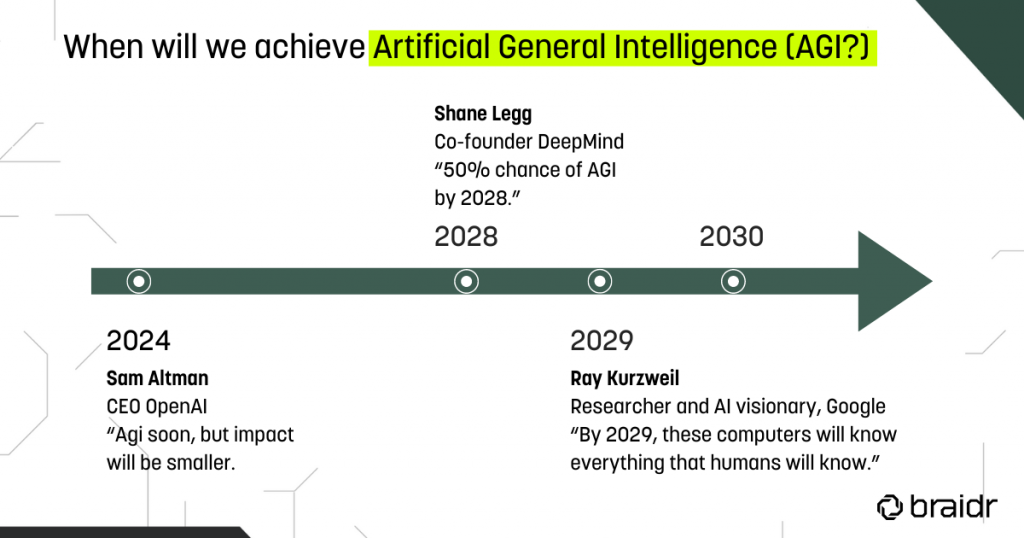The road to AGI: when will we get there?
Explore expert predictions, challenges, and the potential impact of Artificial General Intelligence (AGI) on businesses.

We stand on the edge of a technological revolution, and Artificial General Intelligence (AGI) is set to be its most disruptive force. Imagine machines that can think, learn, and adapt just like humans.
This isn’t science fiction—it’s the future.
For business leaders, AGI is a powerful wave that could either propel your company to unprecedented success or sweep it into oblivion. It has the potential to revolutionise industries, reshape markets, and redefine the very essence of work and strategy. That’s why as a business, understanding the potential dangers and opportunities of AGI is crucial for strategic planning and future-proofing.
In this piece, we will delve into expert predictions, explore the inherent challenges, and provide insights on whether AGI poses a risk or an advantage for your business.
What is AGI?
Artificial General Intelligence (AGI) is a form of AI that is capable of understanding, learning, and applying knowledge across a wide variety of tasks, much like a human being.
Unlike narrow AI, which is designed to perform specific tasks such as language translation or image recognition, AGI aims to replicate the flexible and adaptive intelligence found in human cognition. The goal is for machines to possess the ability to solve unfamiliar problems, make reasoned decisions, and adapt to new situations without human intervention. This level of sophistication makes AGI a revolutionary step in AI development, potentially transforming industries ranging from healthcare to finance.
However, the complexity and unpredictability associated with AGI also raise important ethical and safety concerns that businesses must consider.
Tech leader predictions
The timeline for achieving AGI is a topic of intense debate among tech leaders and researchers. Many experts argue that achieving AGI is not a matter of “if,” but “when.”
- Sam Altman, CEO of OpenAI, anticipates that AGI might be developed in the “reasonably close-ish future.” He believes the impact of AGI on the world and employment will be significantly less than currently anticipated.
- Shane Legg, co-founder of Google DeepMind, stated in a tech podcast interview that there is a 50% likelihood of achieving AGI by 2028. He first made this prediction public on his blog in 2011.
- Ray Kurzweil, researcher and AI visionary of Google, is sticking to his original prediction in 1999 that AI will match/surpass human intelligence by 2029. He was talking about the so-called AGI capable of passing the Turing test.

Given these varied perspectives, it’s clear that while the precise timeline for AGI remains uncertain, the consensus is that its development is imminent. In spite of their optimism about AGI’s potential, they have different viewpoints:
- Foundational beliefs: Legg believes scalable algorithms and data growth are key to AGI. Kurzweil focuses on merging human and machine intelligence through the Law of Accelerating Returns, while Altman centres on rapid advancements in AI capabilities and their economic impact.
- Focus areas: Legg emphasises scalable algorithms and current AI research advancements. Kurzweil is more concerned with philosophical and societal implications, such as immortality and human-machine integration. Altman highlights the economic transformations and acknowledges unpredictability in technological progress.
- Approach to safety and risks: Legg stresses ongoing research in interpretability and reinforcement learning. Kurzweil maintains an optimistic view, believing technological advancements will overcome risks. Altman balances optimism with caution, highlighting the importance of addressing safety concerns and acknowledging potential delays.
Our Machine Learning Engineer, Robert Vinter, weighs in:
“AGI will represent the ability to find the known in the unknown. Imagine bringing 1, 2, …, n additional dimensions to our 3D vision. Based on how rapid the evolution is, and the huge advancements in LLMs and generative AI capabilities, we are pretty confident that in the next 10 years, we’ll get to AGI. That’s why you shouldn’t let your business fall behind amidst these transformative times. Our team is here to equip you with the tools and insights needed to thrive in an era of unprecedented technological advancements.”
Understand why reaching AGI seems inevitable to most experts
Reaching AGI might sound far-fetched, but it’s actually a reasonable objective when you consider the following:
- Human intelligence is fixed unless we integrate our cognitive abilities with machines. Although Elon Musk’s neural lace startup aims to achieve this, brain-computer interface research is still in its infancy.
- Machine intelligence relies on algorithms, processing power, and memory, all of which have been increasing exponentially.
- We have been successful in providing machines with the algorithms needed to maximise their processing power and memory. Given that human intelligence is static while machine intelligence is rapidly advancing, machines will inevitably surpass us unless there is an unknown limitation to their intelligence, which we have not yet encountered.
Are there any challenges?
Ethical considerations
As we move closer to developing AGI, ethical considerations become increasingly important. Ensuring that AI systems operate within ethical boundaries poses a significant challenge. This includes addressing issues such as bias, transparency, accountability, and the potential for misuse.
Ethical AI development requires establishing robust guidelines and frameworks to ensure that these systems act in ways that are fair, just, and beneficial to society. Balancing innovation with ethical responsibility is a critical and ongoing challenge in this field.
Adaptable AI Systems
In the realm of research and development, AGI’s primary hurdle is creating a system that can comprehend and adapt to input context in the same way humans do.
Researchers are exploring innovative methods to enable algorithms to think more creatively to overcome this obstacle. For instance, some are investigating the potential for intelligent AI systems to undergo continual learning throughout their lifespan.
Uncertainty
Human intelligence excels at handling uncertainty, which arises when information is incomplete, limited, or contradictory. This is a fundamental aspect of our ever-changing and evolving world, filled with random, unpredictable, and unknown events.
People employ probabilistic reasoning, intuition, common sense, heuristics, and other strategies to make decisions and take action under uncertain conditions, even if those decisions are not always optimal or perfectly rational. Replicating this ability in machines represents a significant challenge in the fields of modelling and computing.
Hardware limitations
Are we even close to achieving AGI? Building these advanced AI systems is complex and demands substantial computing power, which has led to the development of specialised hardware like GPUs and TPUs.
These components are expensive, contributing to the weeks and months required to develop a precise and robust AI system, considering the significant time, data, and other resources involved.
A look ahead to the future of AGI
What does AGI mean for the future? The possibilities are vast, ranging from addressing global challenges to revolutionising e-commerce, positioning you at the forefront of innovation.
Visionaries might see a bright horizon where AGI streamlines business operations and unlocks new markets. But cautious voices remind to stay vigilant against misuse and inadvertent outcomes.
If you’re looking to harness the power of AI that hinges on a robust strategic foundation, get in touch with our team.
Considering sharing with others


)